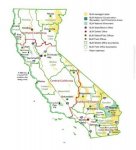Great information in this thread, thanks for this. I have bought some land in Jackson Hole, WY, that is right next to the Wildlife Elk Refuge, as a site for a custom log home we are putting together. Have some good friends there who call that land 'BLM Land' and it's good to know that it will never be built on. (we hope) Our lot is only 10 acres, but the BLM land is our backyard and it is gorgeous and seems to go on forever. So, any and all frequency information for BLM is good news for me right now. I am compiling my own FLs in my scanners for everything Teton county and more. Keep it coming!

JD
kf4anc
I wasn't aware that there is any BLM land near Jackson, WY, but found there is some. Take a look at this map and article from a couple of years ago,
Game and Fish open to BLM land transfers
From my dad,
"Most of these parcels are in the riparian areas along the Snake River, however it looks like there is a 40 acre parcel along the Gros Ventre River that borders the Elk Refuge. The National Elk Refuge is managed by the U.S. Fish and Wildlife Service and is not BLM land. This article highlights that you can't think of federal land ownership, especially those lands that are scattered or next to private land being developed, as remaining in federal ownership forever. Isolated parcels of federal land that have development potential often have enough value that they are used to consolidate land ownership elsewhere or pick up valuable land that is surrounded entirely by National Forest land, National Wildlife Refuge land, National Park land, or BLM land. Often these isolated private lands have high value resources, such as recreation, wildlife/fisheries, scenic, watershed or may even be surrounded by Congressionally designated wilderness lands.
My dad was involved in surveying to various degrees during his civil engineer career with the U.S. Forest Service. Sometimes they would get a rush job for surveying the boundaries of federal lands being transferred from public ownership to private ownership and for the private ownership transferred into public ownership in exchange. These rush jobs would come about while the exchange was at a critical stage of the process and the actual location of the lands came into question. Land exchanges are very complex and difficult to accomplish. Sometimes developers or others will buy up key pieces of private lands elsewhere that have public resource value and wait 10 or more years until a land exchange can be completed. Sometimes groups such as the Trust for Public Lands or the Nature Conservancy will buy up private parcels and make the land exchange, then sell the private land to raise more funds to buy more private land for future land exchanges that will result in a public resource benefit. Sometimes the Nature Conservancy will retain the land, purchase additional private lands adjecent to the parcel they traded for to establish a preserve, which they establish due to some critical vegetation or wildlife species that might exist on those lands.
Public land management is complex and often not straightforward. It is best not to rely on or place much credibility on "word of mouth" information. Some of the worst information often comes from real estate agents/brokers/firms."
Thanks Daddy! He's pretty sharp at 92, huh!
I've not seen any listings for the BLM having any communications infrastructure close to that area. The parcels involved are remote from other BLM managed land and are small in size. There might even be a cooperative agreement with the U.S. Forest Service or U.S. Fish and Wildlife Service to manage these parcels for the BLM in due to their distance from other BLM lands.
I'm glad the maps helped you and I hope this long post will also do so.


